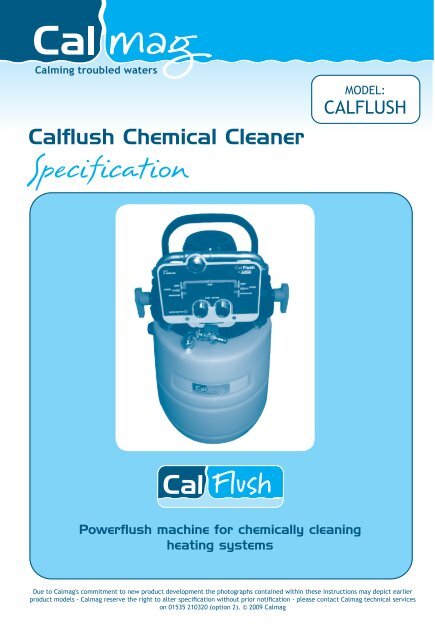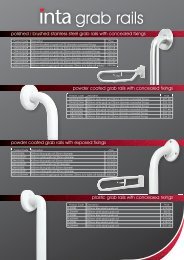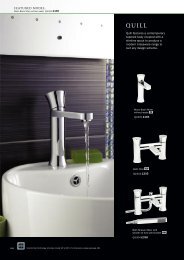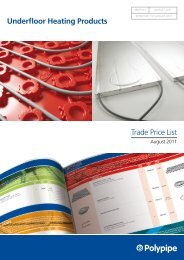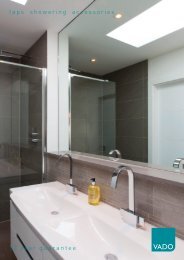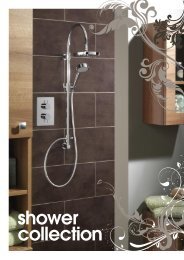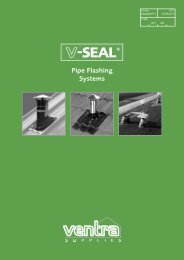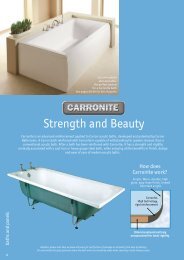Specification - Brands of Watford
Specification - Brands of Watford
Specification - Brands of Watford
Create successful ePaper yourself
Turn your PDF publications into a flip-book with our unique Google optimized e-Paper software.
Calming troubled waters<br />
Calflush Chemical Cleaner<br />
<strong>Specification</strong><br />
MODEL:<br />
CALFLUSH<br />
Powerflush machine for chemically cleaning<br />
heating systems<br />
Due to Calmag's commitment to new product development the photographs contained within these instructions may depict earlier<br />
product models - Calmag reserve the right to alter specification without prior notification - please contact Calmag technical services<br />
on 01535 210320 (option 2). © 2009 Calmag
Calflush Chemical Cleaner<br />
Introduction:<br />
Calmag have many years experience in the industrial<br />
heating and water treatment industry, working in conjunction with a number<br />
<strong>of</strong> heating engineers who possess Powerflushing equipment. Together we<br />
have evolved a faster, cheaper, more effective method <strong>of</strong> cleaning domestic<br />
systems, using experience gained from large scale industrial heating and<br />
cooling systems and trials with heating engineers.<br />
The Current Problem:<br />
It is well known that there are two major<br />
contributors to the fouling <strong>of</strong> heating systems:1) Scale- this mainly forms in<br />
the heat exchanger but is rarely found in the radiators or pipes unless the<br />
circulatory water is above 73 degrees Celsius. For this reason, it is not<br />
usually necessary to use an acid based cleaner in the radiators. 2)<br />
Sludges- these are commonly referred to as ‘magnetite’ which can be<br />
present in radiators and even in parts <strong>of</strong> pumps. There seems to be a link<br />
between noisy pumps and the presence <strong>of</strong> sludge, so removing the sludge<br />
tends to quieten the pumps. The problem with the traditional powerflushing<br />
method is that it attempts to remove the sludge through the use <strong>of</strong> force,<br />
one radiator at a time. This can be time consuming, <strong>of</strong>ten ineffective and<br />
disturbs all the radiator settings in the process.<br />
The Calmag Solution:<br />
For dirty systems, we have found that a combination<br />
<strong>of</strong> the products is a quick, efficient and economical method <strong>of</strong><br />
Powerflushing. By cleaning all radiators in one loop, customers are now<br />
Powerflushing in a round two hours.<br />
Major Benefits:<br />
* Can reduce Powerflushing time considerably.<br />
* Does not leave any cold spots.<br />
* Quietens boilers and pumps.<br />
* Only requires setting up the Powerflush<br />
machine once.<br />
* Cleans even heavily silted systems.<br />
* The faster more efficive way to clean central<br />
heating systems using a combination <strong>of</strong> three<br />
products and cleaning all radiators in one loop.
Calming troubled waters<br />
Sludge and Flux Remover<br />
Sludge and Flux Remover cleans and neutralises flux<br />
residues debris, oil and grease from new and old<br />
systems, as well as flocculating magnetite sludges<br />
and particulate residues, to facilitate their easy<br />
removal with a Powerflush machine. Sludge and Flux<br />
Remover is suitable for use with all components.<br />
It will not harm aluminium and requires no<br />
neutralisation. This product can remove light rust and<br />
helps descale and s<strong>of</strong>ten water.<br />
Silt Free<br />
Silt Free is a flocculent blend that is typically used<br />
to shift deposits <strong>of</strong> silt, mud and sand etc from open<br />
drains. Silt Free gives the silt particles buoyancy in<br />
water and by imparting a small charge on individual<br />
paticles causing them to repel each other. Material<br />
treated with Silt Free will not form a solid mass<br />
again. This enables the silt and sludge content <strong>of</strong><br />
heating systems to be more easily removed with<br />
Powerflushing.<br />
Powerflush Descaler<br />
Powerflush Descaler loosens and dissolves corrosion<br />
deposits, limescale and ironoxides typically found in<br />
heating systems with circulation and heat transfer<br />
problems. Note: All these products are ‘water<br />
neutralised’ but if time is an issue, use an acid<br />
neutraliser on the Powerflush Descaler for faster<br />
results.<br />
The contents <strong>of</strong> the Powerflush pack are sufficient<br />
to Powerflush two average domestic heating<br />
systems, each at 10 radiators.
Calflush Chemical Cleaner<br />
How It Works....<br />
The Sludge and Flux Remover and Silt Free is<br />
added to the whole system (boiler and radiators)<br />
to begin the break up <strong>of</strong> the magnetite and sludge,<br />
which usually contains a mix <strong>of</strong> oil, dirt and scale.<br />
As the Sludge and Flux Remover frees up these<br />
deposits, the Silt Free acts as a flocculent to keep<br />
the particles in suspension until they are flushed<br />
out <strong>of</strong> the system. The Silt Free works by imparting<br />
a small charge on individual paticles causing them<br />
repel each other. The polymer nature <strong>of</strong> the<br />
product also gives the particles additional<br />
buoyancy in water, so when there is water flow<br />
they go in to suspension and are easily flushed out.<br />
Once deposits <strong>of</strong> sludge, silt, sand and mud have<br />
been treated with Silt Free, they cannot reform<br />
into a solid mass whilst in the water.<br />
* We recommend after the powerflush process is<br />
complete, using Calchem as the inhibitor or any<br />
other approved inhibitor.
Calming troubled waters<br />
Preparation Before Powerflushing<br />
* Isolate the cold water supply and electrical supply to the heating system.<br />
* Manually close any automatic air vents.<br />
* For open vented systems, drain the header tank completely and either<br />
cap-<strong>of</strong>f or join together, the open vent and expansion/cold feed pipes.<br />
* Mark, or make a note, <strong>of</strong> the position <strong>of</strong> the lockshield valves (this will<br />
assist in the quick re-balancing <strong>of</strong> the system upon completion), adjust to<br />
the fully open position and remove any thermostatic radiator valve (TRV)<br />
heads. This will ensure maximum flow through the valves.<br />
* Set any zone or diverter valves to the manual open position, where<br />
applicable.<br />
* Anti-gravity and non-return valves should be bridged, or temporarily<br />
removed.<br />
Powerflushing Procedure<br />
a. Ensure that the 2 valves are in the closed position. Connect the mains<br />
water supply to the CalFlush unit and fit the overflow hose to the unit.<br />
(Note: Hose without a fitting is for the overflow and inlet).<br />
b. Fit the pipe with one fitting to the dump connection and feed into a foul<br />
drain.<br />
c. Connect the CalFlush unit to the system and fill the tank with fresh clean<br />
water to the maximum level mark.<br />
d. Plug the CalFlush unit into a standard electrical socket.<br />
e. Open both isolator valves to the circulate position and ensure that all<br />
radiator valves are fully open.<br />
f. Unscrew the tank cap and leave open.<br />
g. Turn on the pump and begin to flush the system for a minimum <strong>of</strong> 10<br />
minutes, reversing the flow through the unit on a regular basis via<br />
the flow reverser handle.<br />
h. Keep a check on the water level in the tank. If this level drops below the<br />
minimum mark, top up with fresh clean water.
Calflush Chemical Cleaner<br />
i. Open the water inlet tap to fill the tank with fresh clean water and open<br />
one dump valve only. Note, if the flow reverse handle is pointing to<br />
the left, open the left hand dump valve. DO NOT LET THE TANK EMPTY.<br />
To keep a constant level <strong>of</strong> water in the tank, the dump valve should be<br />
closed slowly until an equilibrium has been achieved.<br />
j. When the water is seen to be clean running to drain, turn <strong>of</strong>f the water<br />
inlet and dump valve.<br />
k. Add 1 litre <strong>of</strong> Sludge & Flux Remover (per 10 radiators) to the tank and<br />
circulate around the system for approximately 10 minutes, again changing<br />
the flow direction on a regular basis.<br />
l. Add approximately 150ml <strong>of</strong> Silt Free to the tank and circulate for a<br />
further 15 minutes. If possible, heat the system to approximately 30<br />
degrees Celsius.<br />
m. Turn <strong>of</strong>f boiler.<br />
Note: Each radiator is recommended to be flushed individually throughout<br />
the system. This will ensure the full removal <strong>of</strong> contaminants.<br />
n. Repeat process i to empty the system completely <strong>of</strong> the cleaning solution<br />
and refill the system with fresh clean water.<br />
o. When the system is full with fresh clean water turn <strong>of</strong>f the pump and<br />
close both isolator valves.<br />
p. Isolate the radiators as this will ensure that the Powerflush Descaler will<br />
only circulate around the primary loop to the heat exchanger. Leave last<br />
radiator on system open to form loop.<br />
q. Add approximately 500ml <strong>of</strong> Powerflush Descaler to the tank, open both<br />
isolator valves, and start the pump. The Powerflush Descaler should<br />
be pumped around the system for a minimum <strong>of</strong> 30 minutes, again<br />
changing the flow direction on a regular basis.<br />
r. Repeat process i to empty the system completely. A book <strong>of</strong> pH papers<br />
will give results <strong>of</strong> the acid content <strong>of</strong> the water after flushing. A pH level<br />
<strong>of</strong> 7, or slightly above is acceptable. If the pH is below 7, continue<br />
dumping and refilling the system, as above, with fresh clean water until<br />
the pH reading is achieved.
Calming troubled waters<br />
s. After flushing the primary loop, and achieving the desired pH level, turn<br />
<strong>of</strong>f the water inlet and dump valve. Turn <strong>of</strong>f the pump and isolator valves.<br />
t. Open all radiators fully.<br />
u. Add 1 litre <strong>of</strong> CalChem inhibitor (per 10 radiators), or any other approved<br />
inhibitor, to the tank and open the isolator valves and start pump to<br />
circulate the CalChem inhibitor around the system for approximately 20<br />
minutes, changing the flow direction on a regular basis.<br />
v. The Powerflush and inhibiting process is now complete.<br />
w. Please note that the inhibitor may need to be topped up on an annual<br />
basis. Levels <strong>of</strong> the CalChem inhibitor can be checked by use <strong>of</strong> a Calmag<br />
Refractometer - please call for additional details.<br />
x. Note. If a new boiler is being installed, powerflush the system prior to the<br />
boiler installation if possible.
Telephone: 01535 210320<br />
Fax: 01535 210321<br />
E mail: sales@calmagltd.com<br />
Website: www.calmagltd.com<br />
Calming troubled waters<br />
Calmag, Units 3-6, Crown Works,<br />
Bradford Road, Sandbeds, Keighley,<br />
West Yorkshire BD20 5LN


